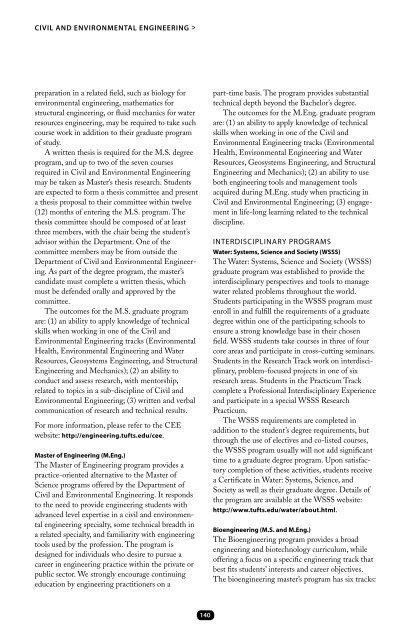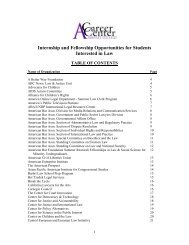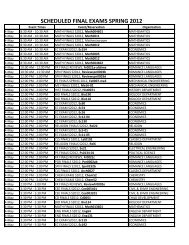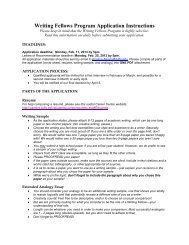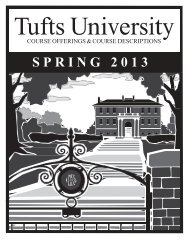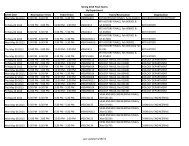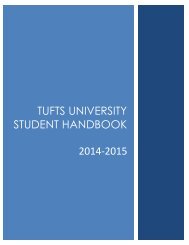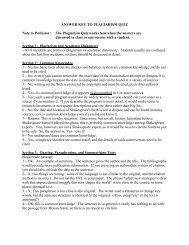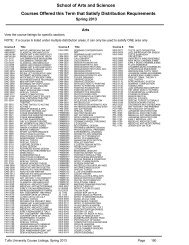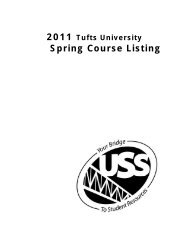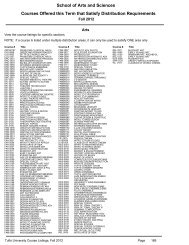2013â2014 The Bulletin - USS at Tufts - Tufts University
2013â2014 The Bulletin - USS at Tufts - Tufts University
2013â2014 The Bulletin - USS at Tufts - Tufts University
Create successful ePaper yourself
Turn your PDF publications into a flip-book with our unique Google optimized e-Paper software.
Civil and Environmental Engineering ><br />
prepar<strong>at</strong>ion in a rel<strong>at</strong>ed field, such as biology for<br />
environmental engineering, m<strong>at</strong>hem<strong>at</strong>ics for<br />
structural engineering, or fluid mechanics for w<strong>at</strong>er<br />
resources engineering, may be required to take such<br />
course work in addition to their gradu<strong>at</strong>e program<br />
of study.<br />
A written thesis is required for the M.S. degree<br />
program, and up to two of the seven courses<br />
required in Civil and Environmental Engineering<br />
may be taken as Master’s thesis research. Students<br />
are expected to form a thesis committee and present<br />
a thesis proposal to their committee within twelve<br />
(12) months of entering the M.S. program. <strong>The</strong><br />
thesis committee should be composed of <strong>at</strong> least<br />
three members, with the chair being the student’s<br />
advisor within the Department. One of the<br />
committee members may be from outside the<br />
Department of Civil and Environmental Engineering.<br />
As part of the degree program, the master’s<br />
candid<strong>at</strong>e must complete a written thesis, which<br />
must be defended orally and approved by the<br />
committee.<br />
<strong>The</strong> outcomes for the M.S. gradu<strong>at</strong>e program<br />
are: (1) an ability to apply knowledge of technical<br />
skills when working in one of the Civil and<br />
Environmental Engineering tracks (Environmental<br />
Health, Environmental Engineering and W<strong>at</strong>er<br />
Resources, Geosystems Engineering, and Structural<br />
Engineering and Mechanics); (2) an ability to<br />
conduct and assess research, with mentorship,<br />
rel<strong>at</strong>ed to topics in a sub-discipline of Civil and<br />
Environmental Engineering; (3) written and verbal<br />
communic<strong>at</strong>ion of research and technical results.<br />
For more inform<strong>at</strong>ion, please refer to the CEE<br />
website: http://engineering.tufts.edu/cee.<br />
Master of Engineering (M.Eng.)<br />
<strong>The</strong> Master of Engineering program provides a<br />
practice-oriented altern<strong>at</strong>ive to the Master of<br />
Science programs offered by the Department of<br />
Civil and Environmental Engineering. It responds<br />
to the need to provide engineering students with<br />
advanced level expertise in a civil and environmental<br />
engineering specialty, some technical breadth in<br />
a rel<strong>at</strong>ed specialty, and familiarity with engineering<br />
tools used by the profession. <strong>The</strong> program is<br />
designed for individuals who desire to pursue a<br />
career in engineering practice within the priv<strong>at</strong>e or<br />
public sector. We strongly encourage continuing<br />
educ<strong>at</strong>ion by engineering practitioners on a<br />
part-time basis. <strong>The</strong> program provides substantial<br />
technical depth beyond the Bachelor’s degree.<br />
<strong>The</strong> outcomes for the M.Eng. gradu<strong>at</strong>e program<br />
are: (1) an ability to apply knowledge of technical<br />
skills when working in one of the Civil and<br />
Environmental Engineering tracks (Environmental<br />
Health, Environmental Engineering and W<strong>at</strong>er<br />
Resources, Geosystems Engineering, and Structural<br />
Engineering and Mechanics); (2) an ability to use<br />
both engineering tools and management tools<br />
acquired during M.Eng. study when practicing in<br />
Civil and Environmental Engineering; (3) engagement<br />
in life-long learning rel<strong>at</strong>ed to the technical<br />
discipline.<br />
Interdisciplinary Programs<br />
W<strong>at</strong>er: Systems, Science and Society (WSSS)<br />
<strong>The</strong> W<strong>at</strong>er: Systems, Science and Society (WSSS)<br />
gradu<strong>at</strong>e program was established to provide the<br />
interdisciplinary perspectives and tools to manage<br />
w<strong>at</strong>er rel<strong>at</strong>ed problems throughout the world.<br />
Students particip<strong>at</strong>ing in the WSSS program must<br />
enroll in and fulfill the requirements of a gradu<strong>at</strong>e<br />
degree within one of the particip<strong>at</strong>ing schools to<br />
ensure a strong knowledge base in their chosen<br />
field. WSSS students take courses in three of four<br />
core areas and particip<strong>at</strong>e in cross-cutting seminars.<br />
Students in the Research Track work on interdisciplinary,<br />
problem-focused projects in one of six<br />
research areas. Students in the Practicum Track<br />
complete a Professional Interdisciplinary Experience<br />
and particip<strong>at</strong>e in a special WSSS Research<br />
Practicum.<br />
<strong>The</strong> WSSS requirements are completed in<br />
addition to the student’s degree requirements, but<br />
through the use of electives and co-listed courses,<br />
the WSSS program usually will not add significant<br />
time to a gradu<strong>at</strong>e degree program. Upon s<strong>at</strong>isfactory<br />
completion of these activities, students receive<br />
a Certific<strong>at</strong>e in W<strong>at</strong>er: Systems, Science, and<br />
Society as well as their gradu<strong>at</strong>e degree. Details of<br />
the program are available <strong>at</strong> the WSSS website:<br />
http://www.tufts.edu/w<strong>at</strong>er/about.html.<br />
Bioengineering (M.S. and M.Eng.)<br />
<strong>The</strong> Bioengineering program provides a broad<br />
engineering and biotechnology curriculum, while<br />
offering a focus on a specific engineering track th<strong>at</strong><br />
best fits students’ interests and career objectives.<br />
<strong>The</strong> bioengineering master’s program has six tracks:<br />
140


